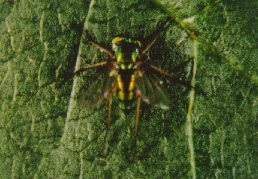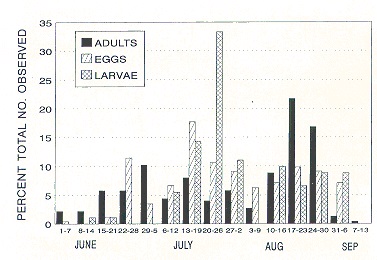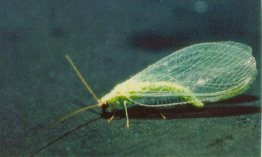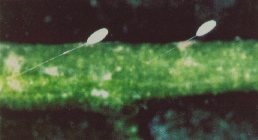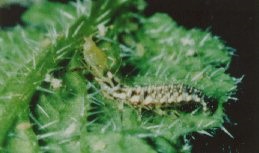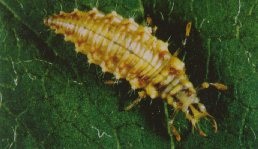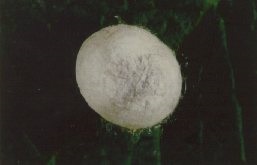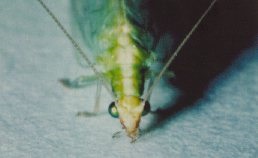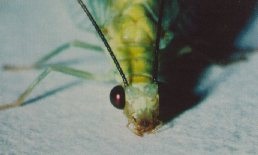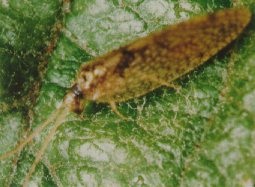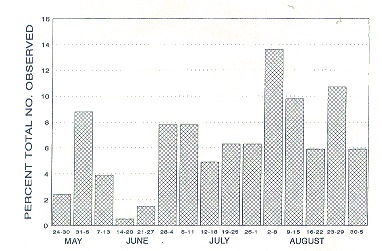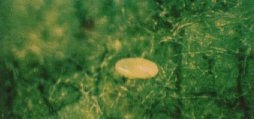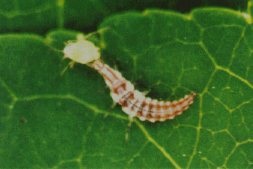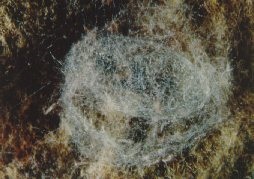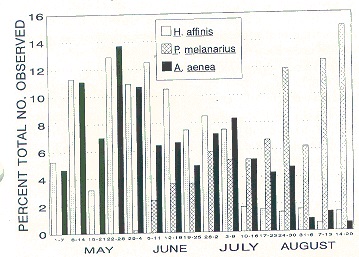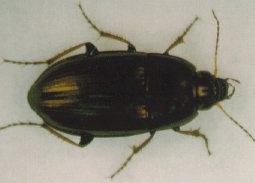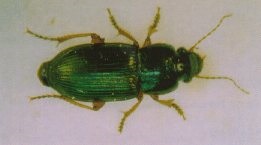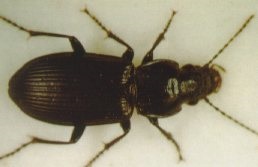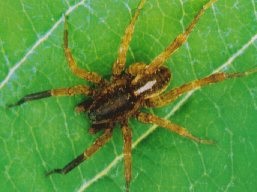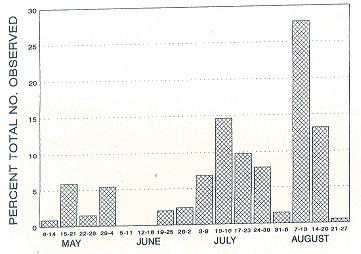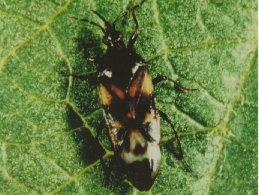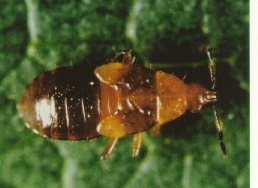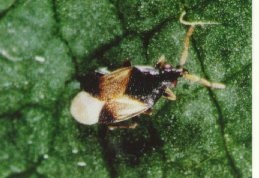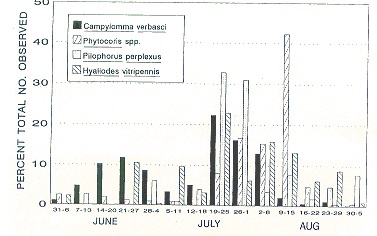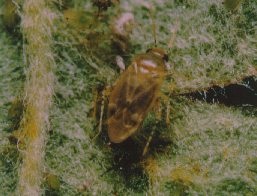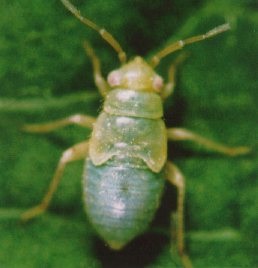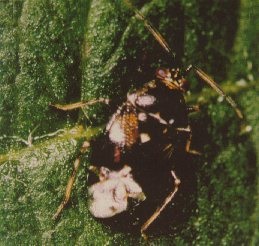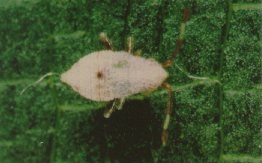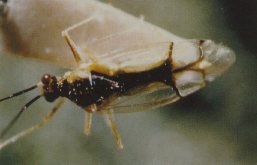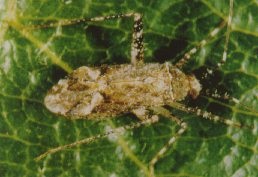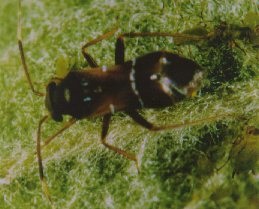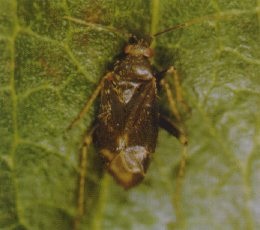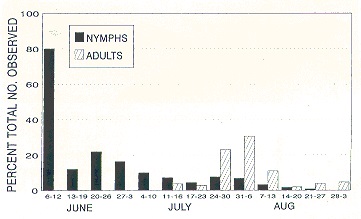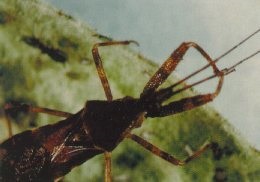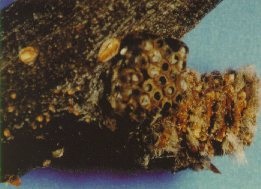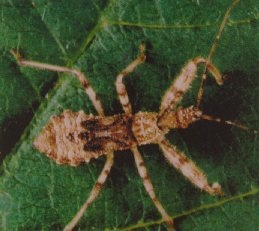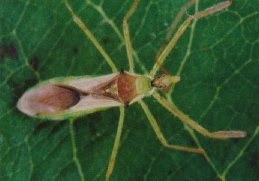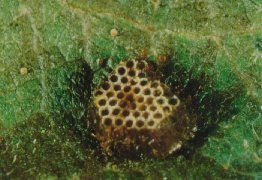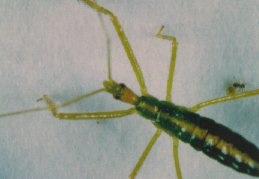Beneficial insects in tree fruit orchards in southern Ontario
Learn about the benefits of using natural predators to help control pests in tree fruit orchards.
ISSN 1198-712X, Published February 1996
Introduction
Integrated pest management programs to control fruit pests emphasize reduced pesticide use based on monitoring the activity and abundance of pest populations, and on careful selection of pesticides to maximize effects against the target pest and to minimize adverse effects on beneficial species. When pesticide resistance develops in one or more major pest species, strategies are developed to manage this resistance. In fact, successful pest management programs are dependent not only on how much "control" is achieved, but also on how much a particular strategy reduces the risk to the grower who uses it, i.e., to what extent the profitability of the operation is affected.
In any crop, usually several pest species are capable of causing economic damage in a growing season. For example, more than 60 pest species are present in apple orchards in southern Ontario in most seasons, but only 8–10 of these species may he of economic importance in any one year. To control these pests, at least 4–6 insecticide sprays are applied during the season. More sprays may be applied if pests develop resistance to currently used insecticides. Higher rates of pesticides, as well as "switching" of pesticides, may also be necessary to obtain acceptable economic control. Under these conditions, populations of natural enemies may be drastically reduced or eliminated, allowing a resurgence of pest populations. Also, formerly innocuous species may assume pest status. There is, therefore, a need to develop truly integrated programs that will provide economic control of pests and at the same time allow natural enemies to survive.
Because the inter-relationships between pests and natural enemies (parasites, predators, disease) are extremely complex, they have proven difficult to analyze, and in many cases are still poorly understood. This is especially true with regard to the role of polyphagous predators in suppressing pest populations. Failure to fully understand and evaluate the role of these predators has greatly reduced our ability to use and manipulate them to our advantage in the fruit crop ecosystem. Because polyphagous predators are effective at low host densities they may suppress the rapid buildup of pest populations in the early stages of an infestation. Many species, especially among the Hemiptera, also imbibe plant sap, which enables them to survive periods when prey is scarce or unavailable.
To incorporate the beneficial effects of these predators into management systems, intensive biological studies of predator complexes and evaluations of the impact of individual species against one or more pests must be undertaken so that quantitative relationships between pest and prey can be established. Such studies should pay particular attention to those factors that influence their abundance, dispersal and efficacy. Methods of economically mass-producing these predators should also be developed so that natural populations could be augmented when necessary. Application of biotechnology may allow the development of predators with desirable characteristics that will enhance their efficacy, for example, resistance to pesticides.
In fruit orchards in southern Ontario several species of polyphagous arthropod predators are present. For example, in unsprayed apple orchards, more than 109 species of insect predators belonging to six orders and 21 families have been observed. Conservation and manipulation of these predators are important in the development of sound ecologically based management systems. The series of factsheets that has been prepared should facilitate identification of the more important species, and give some information on their occurrence and activity, and on their potential as bio-control agents.
Diptera
Dolichopodidae (Long-Legged Flies)
Dolichopodids are small (4–9 mm), slender flies, that are usually brilliantly colored with metallic hues of green, blue, copper, gold, and silver. Some species are grey or black. They are characterized by simple wing venation and long slender legs. Dolichopodids occur in diverse habitats; larvae are commonly found in moist soil and under tree bark and adults are often abundant near streams, and are found on foliage, tree bark, and flowers of various plants. Both larvae and adults are predaceous on many other insects and small arthropods, including mites, and the larvae of some species are phytophagous. Dolichopodids overwinter as larvae and adults are active in apple orchards in the summer. Species of Condylostylus (Figure 1) are generally most abundant. There is usually one generation per year, although a partial second generation may develop in some species.
Neuroptera
Chrysopidae (Green Lacewings)
Adult chrysopids are medium-sized (7–15 mm) insects, with yellowish-green to grey bodies, with red, yellow, or brown markings. They are cosmopolitan in distribution. Chrysopids have large compound eyes and large wings, which are held roof-like over the body. They are not capable of sustained flight, but usually disperse downwind after sunset. The presence of aphid honeydew may interrupt or arrest this dispersal flight. Adults are most active on warm sunny days with little wind, and are both predaceous and phytophagous. Sexually mature adults contact each other by substrate-borne signals or "calls" and, after mating, deposit eggs on long, slender stalks, singly or in groups of 20–30. Each female lays several hundred eggs which hatch in 4–12 days. There are three larval instars during the developmental period of about 11–12 days. The larvae are active on plant foliage and hunt their prey which consists largely of aphids and other soft-bodied insects. Larvae of some species cover their bodies with trash or debris for protection. Pupation takes place in silken cocoons, which are found in concealed places and in the soil, and lasts about 19 days. There are several generations per year. Several species occur in apple orchards in southern Ontario (Figure 2).
Chrysoperla carnea Stephens
Chrysoperla carnea adults (7–10 mm) are yellowish-green with a prominent creamy stripe running along the back, and pale green wing venation (Figure 3). A dark-reddish band runs from the base of each eye to the mouth, with a reddish spot present near each eye. Adults overwinter and are active from about early May to mid-September. They feed mainly on aphid honeydew and also on nectar and other plant fluids. Mating and oviposition generally do not occur at temperatures below 8°C. Each female deposited about 200 eggs (range: 26–506) in the laboratory at 24 °C and 75% R.H., and the oviposition period averaged 46 days. Eggs (Figure 4) are first found in apple orchards in late May to early June and larvae are present 4–12 days later. The larvae (Figure 5 and Figure 6) feed on aphids, primarily the green apple aphid, Aphis pomi DeGeer, other soft-bodied insects, and phytophagous mites. They occasionally pierce plant tissues in search of moisture and/or food. The larval period lasted 6–17 days in the laboratory. Mature larvae spin silken cocoons (Figure 7) under bark scales or on the under surfaces of leaves, or on twigs, with the pupal period lasting about 19 days. There are probably 3–4 generations per year. Chrysoperla carnea is the most abundant chrysopid species found in apple orchards in southern Ontario.
Chrysopa nigricornis Burmeister
Adult Chrysopa nigricornis are the largest (12–15 mm) Cbrysopidae found in fruit orchards in southern Ontario. They are distinguished from other chrysopids by the basal segments of their antennae, which are dark brown to black (Figure 8(a) and Figure 8(b)). Also, a dark brown stripe is present on each side of the face, and two black spots anteriorly on the sides of the body. Adult C. nigricornis are more abundant in pear than apple orchards, and feed primarily on pear psylla. Larvae are also predaceous and have a pair of lateral tubercles on the first abdominal segment. Chrysopa nigricornis overwinters as a pupa in a silken cocoon and adults are active in late spring. In the laboratory each female laid an average of 682 eggs (range: 47–1617 eggs) at 24°C and 75% R.H.
Chrysopa oculata Say
Adult Chysopa oculata are similar in size to C. carnea but have a black band beneath the antennal sockets, a reddish, triangular spot on the head between the antennae, and a reddish face with black dots. The second antennal segment has a black ring. Both adults and nymphs are predaceous and feed primarily on the green apple aphid. Chrysopa oculata overwinters as a pupa in a silken cocoon in the soil and the adults are active in late spring. In the laboratory each female laid an average of 732 eggs (range: 40–1240 eggs) at 24 °C and 75% R.H.
Hemerobiidae (Brown Lacewings)
Adult hemerobjids (Figure 9) are light to darkish-brown, and are smaller than adult chrysopids or green lacewings. They overwinter as adults, or as mature larvae and prepupae within a loosely spun silken cocoon. Adults and larvae are predaceous and feed on aphids, mites, and other soft-bodied arthropods. Adults are active in apple orchards between late May and late August (Figure 10), with a population peak in early August when aphids are abundant. Eggs (Figure 11) are non-stalked, creamy-white in colour with a distinct micropylar knob at the anterior end. They are laid singly on fruit buds and leaves and in bark crevices. Each female lays several hundred eggs, which hatch after about 5 days. The larvae (Figure 12) are creamy-brown with dark reddish-brown stripes and spots. They move their heads from side to side when and walking late stage larvae and do not have a foot pad (pulvillus), which is found in chrysopid larvae. There are three larval instars, and the larval period lasts between 11 and 22 days. The threshold for larval development is about 4 °C. At maturity, larvae spin loose silken cocoons (Figure 13) in rolled leaves, on leaf and flower clusters, and in other protected places. The pupal period lasts between 10–16 days. There are several generations per year. The predominant hemerobius species in apple orchards in southern Ontario is Hemerobius humilinus (L.). Sympherobius amiculus (Fitch) was occasionally observed.
Coleoptera
Carabidae (Ground beetles)
Adult Carabidae or Ground Beetles are elongate, usually flattened beetles that vary greatly in size (3–85 mm) and colour. They are usually dark brown to black, but many species are yellowish or reddish-brown with blue, green, or copper metallic hues. They are ground dwellers and are found under stones and debris on the soil surface or in burrows in the soil. Both larvae and adults are nocturnal and predaceous, but many species are phytophagous and feed on seeds, tender shoots, fruits, and pollen of various plants. Their prey consists of a wide range of soft-bodied arthropods including insects, earthworms, and snails. Eggs are laid in mud cells or cocoons a few cm below the soil surface or attached to the undersides of rocks. The incubation period lasts 14–21 days and there are usually three larval instars. Pupation also occurs in the soil. Some species reproduce in the spring and usually overwinter as adults, while others reproduce in the fall and may overwinter as eggs, larvae, or adults. Adults live for 1–3 years and produce a defensive secretion from abdominal glands that may act as an aggregative pheromone. Fifty-nine species of ground beetles were recovered in apple orchards in southern Ontario, the most abundant being Amara aenea DeGeer, Harpalus affinis Shrank, and Pterostichus melanarius Ill (Figure 14).
Amara spp.
Amara spp. are generally small to medium-sized (4–6 mm) brown beetles that have a broad prothorax and short legs, and forage in open areas with sparse but tall vegetation. The adults are both predaceous and herbivorous, and often climb vegetation in search of food. The larvae are primarily carnivorous. Amara spp. hibernate as both larvae and adults. In addition to A. aenea, three species of Amara have been recovered in fruit orchards in southern Ontario, viz: A. familiaris Dft., A. patruelis DeGeer and A. torrida Pnz.
Amara aenea DeGeer
This is a European species that is widely distributed in North America. Adults (Figure 15) are good fliers and like dry, open areas with sandy soil. They are small and dark brown with protruding frontal angles on the prothorax. In apple orchards, adult A. aenea feed on the seeds of many weed species and are often found near chickweed, Stellaria media (L.) Agrill. Adults, like the larvae, are also carnivorous and feed on small soft-bodied insects. Amara aenea hibernates mostly in the adult stage.
Harpalus spp.
Harpalus spp. comprise one of the largest carabid genera and are cosmopolitan in distribution. Adults are dark brown to black with a metallic lustre, usually greenish, but sometimes bluish and coppery. Harpalus species are generally most abundant in dry, open areas and prefer sandy soils into which they burrow during the day. Harpalus spp. overwinter both as adults and larvae. In addition to H. affinis, five other species of Harpalus have been recovered in apple orchards in southern Ontario. viz: H. caliginosus Fabr., H. erraticus Say, H. herbivagus Say, H. pennsylvanicus DeGeer, and H. pleuriticus Kirby.
Harpalus affinis Schrank
This is a European species that is now widely distributed in Canada. Harpalus affinis is dark brown, often with the dorsal surfaces of the prothorax and elytra having a metallic green or coppery lustre. Harpalus affinis hibernates as both larvae (mainly third instar) and adults under clumps of grass a few cm under the soil. Adults (Figure 16) are active early in May to mid-to-late September and are good fliers. They are sometimes found on the foliage of shrubs and small trees. They are also taken at light.
After mating, pearly-white eggs (2 mm) are laid individually in the soil. The incubation period is about 14-21 days and larvae are active in the soil from August to about December. Pupae are first present in July and when adults emerge, they feed and seek overwintering quarters.
Adults are both predaceous and phytophagous, and the larvae carnivorous. In the laboratory, adults feed on seeds of several weed species and on smaller animal prey such as pupae of the apple maggot Rhagoletis pomonella Walsh, and first instar larvae of the codling moth, Cydia pomonella L., and apple aphids.
Pterostichus spp.
Pterosuchus spp. are large (28–30 mm), black beetles that are cosmopolitan in distribution and occur in several diverse habitats. They are active and disperse by running rapidly over the soil surface. In addition to P. melanarius, five other species are recovered in fruit orchards in southern Ontario, viz P. lucublandus Say, P. chalcites Say, P. pennsylvanicus LeC., P. mutus Say, and P. patruelis Dej.
Pterostichus melanarius Ill.
Pterostichus melanarius Ill. was introduced into North America from Europe and is now widely distributed on the continent. Its preferred habitat is uncultivated, open land with deep friable soil, over which it disperses by running rapidly on the surface. It has been reported to travel as many as 18–20 m overnight. Males are generally more active than females. Pterostichus melanarius is a fall breeder and overwinters primarily in the larval stage. Some pre-reproductive adults also overwinter, and become reproductively mature in early spring.
Adults (Figure 17) are first active in late May to early June and generally most abundant between mid-July and mid-August. There is generally one activity peak per year, the adults becoming inactive in late September to early October. Eggs, which are pearly-white and 2–3 mm x 1–2 mm, are well developed in the ovaries in summer and are laid in the soil individually. The incubation period lasts about 14 days. Both adults and larvae are carnivorous and adults also fed on the seeds of several weed species in the laboratory. Large prey, such as earthworms and other beetle and Lepidoptera larvae, are apparently preferred to smaller prey. Pterostichus melanarius adults feed extensively on mature larvae of the codling moth, Cydia pomonella L., when these larvae are seeking hibernation sites in late July and August.
Araneae
Lycosidae (Wolf Spiders)
Lycosidae or Wolf Spiders are large (6–13 mm), mainly terrestrial spiders, that inhabit dark, moist habitats, for example, under stones, logs, leaf litter, and other debris on the soil surface. They do not spin webs, but excavate shallow nests, or deep burrows, or cells, which are lined with silk. Species of lycosids are both diurnal and nocturnal, and hunt their prey, primarily insects, which is detected by sight and motion. Both males and females live for 2–3 years and mating probably occurs in the spring and late summer or early fall. Eggs are laid in the soil and protected by the female, which also protects the spiderlings when they emerge. The spiderlings excavate nests in the soil and pass through several instars before attaining maturity. Lycosids are widely distributed in Canada and the U.S. and several species are found in low numbers in apple orchards in southern Ontario.
Trochosa terricola Thorell
Trochosa terricola is a large (8–11 mm) brownish or brownish-red spider, with lighter lateral and median, dorsal markings (Figure 18). Within the median markings are a pair of dark stripes, characteristic of the genus. Trochosa terricola does not burrow but lives under logs, stones, and debris on the soil surface, and is nocturnal in habit. Mating occurs in spring and egg masses are first found in early July. There are eight and nine nymphal stages in the male and female, respectively. Trochosa terricolla tends to be sedentary and depends on sight, movements, and substrate vibrations to detect its prey, which consists of insects and other anthropods. It is active in apple orchards from mid-April to about mid-September, and in the spring probably feeds on exposed living pupae of the spotted tentiform leafminer, Phyllonorycter blancardella (Fabr.).
Hemiptera
Anthocoridae (Flower bugs)
Anthocoridae, or Flower bugs, are distributed world-wide, and have been recorded from several habitats. Forty-one species are known to occur in Canada and Alaska, including four species of Orius and seven species of Anthocoris. Anthocorids are small (2–4 mm), oval-shaped insects, usually dark brown to black, shiny, with light yellowish-brown hemilytra or wing covers. They are generally found on flowers of Compositae and many herbaceous plants, under bark scales, and on the foliage of deciduous trees, for example, birch (Betula spp.), ash (Fraxinus spp.), and willow (Salix spp.). Anthocorids overwinter as adults in sites located within hollow tree trunks, under leaves and trash on the soil surface, and under bark scales. Anthocorids are usually most abundant in fruit orchards late in the season (Figure 19) and are found on both tree foliage and on plants in the understory cover. They are both predaceous and phytophagous, feeding on the immatures and eggs of Lepidoptera, and on aphids, mites, psyllids, thrips, scales, leafhoppers, and the pollen and nectar of several plant species. Several generations occur each year.
In apple orchards in southern Ontario, the predominant species are Orius insidious (Say), and O. tristicolor (White), and in pear orchards Anthocoris nemoralis (Fabr.) is predominant.
Anthocoris spp.
Anthocoris spp. adults are elongate, shiny insects, 3–4 mm (Figure 20), that are found primarily on deciduous trees and herbaceous plants. Both adults and nymphs (Figure 21) feed mainly on psyllids, as well as on aphids, other small insects, and phytophagous mites.
Anthocoris nemoralis (Fabr.) was imported from Europe and released in B.C. against the pear psylla Cacopsylla pyricola Foerster. In fruit orchards in Ontario, adults are first active in late April to early May and most abundant in late July and early August. They occur most frequently on the under surfaces of leaves, searching along the mid-ribs for prey. Each female lays between 100 and 200 eggs, which hatch in approximately 7 days. First stage nymphs are yellow, with the head, tips of the antennae, and abdomen tinged with orange. Late-stage nymphs are yellowish-brown. Nymphal development lasts about 16–18 days. Small aphids tend to be a primary food source of the early nymphal instars.
Orius insidiosus (Say)
Orius spp. adults (1.5–2 mm) (Figure 22), and nymphs are primarily predaceous on phytophagous aphids, and other small insects, particularly thrips, which form the major food of the nymphs.
In fruit orchards, Orius insidiosus has been recovered from cover crops of sunflower and buckwheat, several weeds, and the foliage of apple and pear trees. Mating occurs soon after the adults become active and egg deposition (oviposition) commences within 2–3 days. Females lay an average of 115–140 eggs and the incubation period is about 5 days at 24°C. At that temperature, nymphal development lasts 15–17 days.
Orius tristicolor (White)
Orius tristicolor occurs at similar sites as O. insidiosus but is usually less abundant.
Miridae (Plant bugs)
The mirids form the largest family of the Hemiptera and 81 species are known to occur on fruit crops in Canada. Fifty-seven species are predaceous and the prey of both nymphs and adults comprises mainly aphids and mites, and to a lesser extent, immature Lepidoptera. Some species are also phytophagous and imbibe plant sap by piercing succulent plant tissues. Mirids overwinter either as eggs, which are laid in young shoots and stems or in leaf veins, or as adults in concealed places. The incubation period is about 10–14 days and nymphs are first active in late spring. There are 5 nymphal stages in a developmental period of 25–35 days. Wing pads first appear in the third instar nymph. Adults mate within 2–3 days after emergence and females commence egg laying within 7–10 days. Males die soon after mating and the females soon after ovipositing. Adults are most numerous in fruit orchards in southern Ontario from mid-July through August (Figure 23). There are one or more generations per year. In most years mirids are probably the most important group of insect predators in apple orchards in southern Ontario in mid to late summer.
Campylomma verbasci (Meyer) (Mullein bug)
Campylomma verbasci is an introduced European species that is widely distributed in eastern Canada, British Columbia, and in many northeastern states in the US. Adults are small (3 mm), greyish-brown insects with characteristic black spots on their legs (Figure 24). Campylomma verbasci overwinters as an egg, which is pale yellow and cylindrical and is laid in wood of the current years' growth of pome fruits and other rosaceous plants. First instar nymphs are pale yellow with reddish eyes and the third instar (Figure 25) is pale greenish with characteristic black spots on the legs. Nymphs are first active in early May, and are most abundant from late May through early June. Adults are predominant on apple foliage from about mid-June, and most emigrate from orchards in the summer to alternate hosts such as mullein, potato, sweetcorn and others. They feed and reproduce on these hosts during the summer, flying back into apple and pear orchards in late summer or early fall to lay overwintering eggs. There are probably two or three generations per year.
Adults and nymphs are predaceous and feed primarily on the European red mite, Panonychus ulmi (Koch), and the green apple aphid, Aphis pomi DeGeer, and may suppress populations of these pests in the early stages of an infestation. They also feed on several species of immature Lepidoptera, leafhoppers, and other soft-bodied insects. Campylomma verbasci is also phytophagous and can cause severe damage to apple fruit of some cultivars, for example, "Red Delicious", "Spartan", and "Northern Spy".
Deraeocoris spp.
Deraeocoris spp. adults (Figure 26) are large (4–7 mm), stout insects, which are light to dark-reddish brown or black and are widely distributed in Canada and the US. In addition to apple, they are found on hawthorn, cherry, pear, peach, mulberry, raspberry, and oak. Deraeocoris spp. adults and nymphs (Figure 27) feed primarily on aphids and other Homoptera, phytophagous mites, and immature Lepidoptera. They are often numerous on apple foliage with high infestations of P. ulmi, on which they feed. They also imbibe the honeydew of aphids and are rarely found on plants in the understory cover. Two species, occasionally found in apple orchards, are Deraeocoris fasciolus Knight and Deraeocoris nebulosus (Uhler).
Deracocoris fasciolus (6–7 mm) deposits its elongate, creamy white eggs in the axils of twigs where they overwinter. Nymphs are first active in early spring, and adults are present from late June through late September.
Deraeocoris nebulosus (3–4 mm) overwinters as an adult and is active in spring when mating and oviposition occur. It lays its eggs in the leaf mid-vein, and nymphs are first active in June. They are creamy white, with reddish areas on the head and red eyes and antennae. The third segment of the antenna is pale, as are the legs, which have reddish stripes, spots, and bands. Adults are active from about early July to late September. There is probably one generation per year.
Hyaliodes vitripennis (Say)
Hyaliodes vitripennis adults are elongate (4–5 mm) insects, hyaline or glassy in appearance, with long slender legs and large reddish eyes (Figure 28). The species is widely distributed in eastern North America and has been recovered from apple, pear, plum, grape, elm and oak. Its occurrence in apple orchards varied considerably between years. Hyaliodes vitripennis overwinters as an egg, which is deposited singly just under the bark on small twigs. Two to six eggs may be found at one site. Nymphs are first active in early June and most numerous in late July, and adults are first observed in late July to early August. There is probably one generation per year. Adults and nymphs feed on all stages of phytophagous mites, but are probably most effective as predators of eggs of P. ulmi. Adults are also phytophagous and were frequently observed piercing leaf veins and imbibing sap.
Phytocoris spp.
Phytocoris spp. adults are large insects (6–8 mm), dark grey to light brown, and mottled with yellow, white or dark brown spots (Figure 29). They are widely distributed in Canada and the US and occur on pear, peach, and sweet cherry, in addition to apple. These predators were recovered mainly from apple foliage and generally were not abundant. Their prey consists primarily of aphids and phytophagous mites, but they also feed on immature Lepidoptera. Adults are also capable of feeding on late-stage larvae of the spoiled tentiform leafminer by inserting their mouth parts through the wall of the mine. Phytocoris spp. overwinter in the egg stage and nymphs, which are similar in appearance to the adults, first appear in late May to early June, and are most numerous in late July to early August. Adults are most numerous in early August, and die out in early to mid-September. There is probably one generation per year. Species recovered primarily from apple foliage were P. conspurcatus Knight, which is grey and mottled with brown, and P. neglectus Knight, which is grey and mottled with black.
Pilophorus perplexus Douglas and Scott
Pilophorus perplexus is an elongate, ant-like insect (4–6 mm), dark-reddish brown with a characteristic band of yellowish hairs across the wing covers (Figure 30). This species occurs in eastern North America and is found, usually in small numbers, on apple, pear, and plum. It was recovered from apple foliage (over which it runs very rapidly), and its prey consists primarily of P. ulmi, particularly the egg stage. Pilophorus perplexus overwinters as an egg, which is deposited in the wood of small twigs and branches. Nymphs, which are similar in appearance to the adults, are active from about mid-June and adults from about mid-July through August. There is probably one generation per year. Pilophorus clavatus (Linn.) was also occasionally recovered in apple orchards.
Plagiognathus spp.
Plagiognathus spp. are small (3–5 mm), dark brown to black, shiny insects (Figure 31), which occur in many provinces in Canada and are widespread in the US. They are found in many habitats on a wide range of host plants including fruit trees, mulberry, birch, willow, oak and locust. Plagiognathus spp. were rarely found on apple trees but were present on cover crops and weeds in the understory cover in apple orchards. They overwinter as an egg, which is deposited in 1-year-old twigs. Nymphs are active about mid-May and adults from mid-June to late September. Two species are recovered in apple orchards, namely P. obscurus Uhler, which is dark brown to black with creamy-yellow areas and pale green femora, and P. politus Knight, which is generally darker and has black femora. When present on apple foliage they are frequently found on the terminal growth feeding on A. pomi and other aphids, but they also feed on phytophagous mites. Nymphs are also phytophagous.
Reduviidae (Assassin bugs)
Reduviidae or Assassin bugs vary greatly in size, form, and colour. They are distinguished by a longitudinal groove on the lower body surface into which the rostrum or beak fits. Adults and nymphs of many species are predaceous on other arthropods and some attack vertebrates, including man. Many species are arboreal and are found on fruit trees and other tree species such as oak and walnut. The most abundant species in apple orchards in southern Ontario is Acholla multispinsoa DeGeer (Figure 32).
Acholla multispinosa (DeGeer)
Acholla multispinosa adults (Figure 33) are large insects (10–12 mm), dark brown to greyish-brown, and inhabit the upper and outer regions of the apple tree canopy. Both nymphs and adults are often found in curled leaves and are rarely found on plants in the understory cover. Egg masses containing about 24 eggs each are laid in the axils of buds (Figure 34(a)), or on twigs and limbs (Figure 34(b)), where they pass the winter.
Nymphs (Figure 35) are first active in early June and adults about late July to early August. In the laboratory, oviposition commences about 21 days after emergence. Each female lays an average of 150 eggs in 4–8 egg masses. There are five nymphal instars in a developmental period of 54 days at 24°C and 75% RH. In the orchard there is one generation per year. Both nymphs and adults are predaceous and feed on all stages of the green apple aphid, Aphis pomi DeGeer, adult leafhoppers and other Hemiptera, undetermined species of Diptera and immature Lepidoptera, and on the European red mite, Panonychus ulmi (Koch). They are also capable of feeding on late instar larvae of the spotted tentiform leafminer, Phyllonorycter blancardella Fabr. by inserting their mouth parts through the wall of the leaf mine. In many years A. multispinosa is abundant on apple foliage late in the season.
Zelus luridus Stal
Zelus luridus Stal is an elongate (12–15 mm) insect that is widely distributed in North America. It occurs in low numbers in apple orchards in southern Ontario. Adult Zelus luridus (Figure 36) are yellowish to reddish-brown, with red eyes and distinct, spinous, processes dorso-laterally on the thorax. Males are smaller and darker than females and the spinous processes are not as well developed. Egg masses (Figure 37) are laid on leaves and both nymphs (Figure 38) and adults feed on aphids and other soft-bodied arthropods. Zelus luridus overwinters in the nymphal stage and adults are active in apple orchards from about mid-June to late July. There is generally one generation per year.
Acknowledgements
D. Barber, E. Barszcz (data collection and processing); D. Brown, Y. Bousquest, C.D. Dondale, L.A. Kelton, J.E.H. Martin, A. deRuette, M.D. Schwartz, A. Smetana (species identification); E. Barszcz, W. Lukey, D. Nesbitt, J.G. Van Schagen (photography). B. Solymar, H.M.A. Thistlewood (comments on form and content of factsheets).
Picture of adult Hyaliodes vitripennis (Say) courtesy of G. Laplante and G. Chouinard, Quebec Apple Warning Service, C.P. 48, St. Hyacinthe, Quebec.
